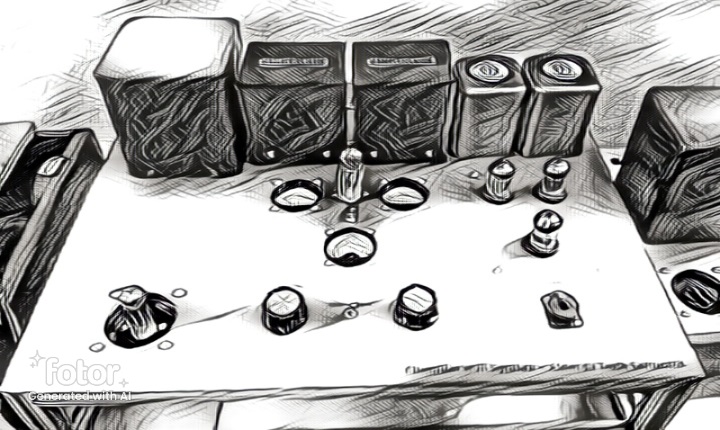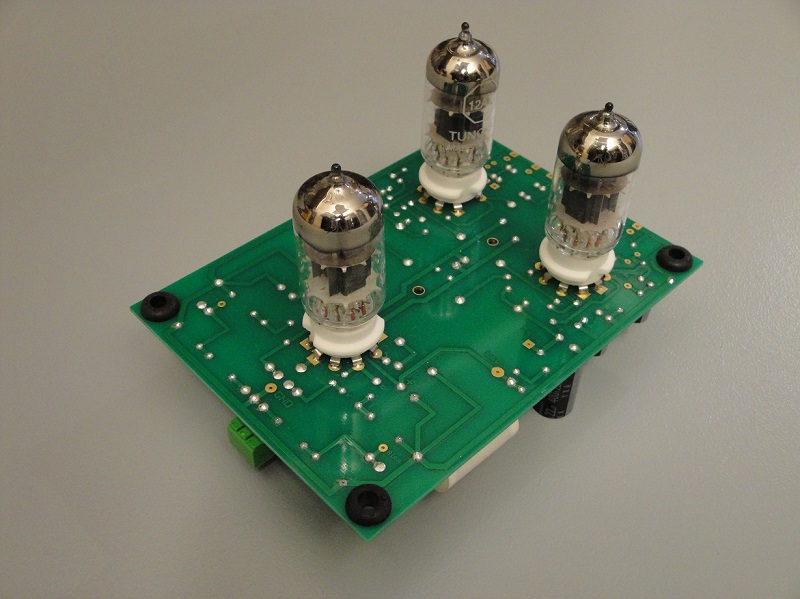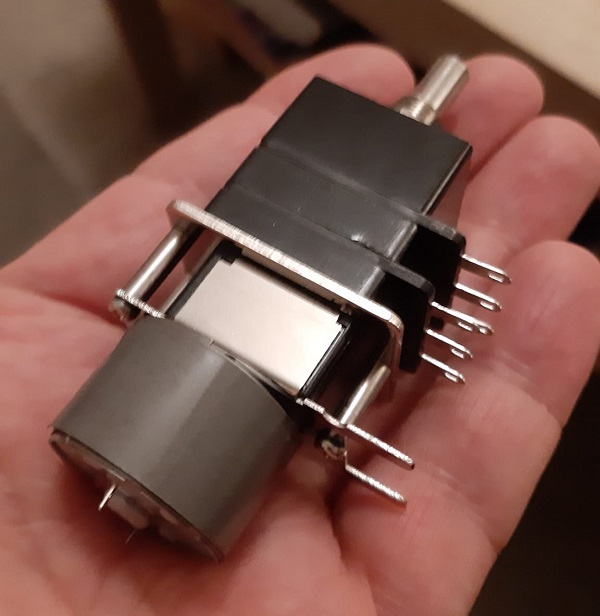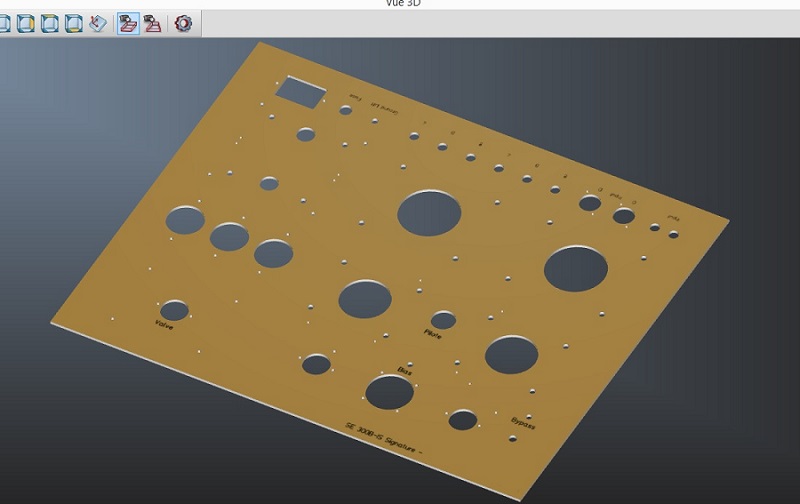Hello everyone,
With this thread, I would like to introduce and share with the community the Orphéus audio project...
It's a fairly ambitious project in both form and content, and it includes many unique features that I would be happy to detail further.
The main objective is to create a complete audio reproduction system using tubes and valves, and incidentally, to inspire members and/or music lovers with a "do-it-yourself" mindset and a minimum of experience in electricity and/or electronics.
The roots, as well as the various configurations adopted in this project, as well as its implementation, stem from a specific design philosophy and adopt certain principles based on convictions and experience.
The Orphéus system is composed of two devices. The first, which is also the heart of the system, is a transformer-based SE preamplifier, also known as a WOT (With Output Transformer) preamplifier.
Its main hardware features are:
Below is an illustration of the device in progress...

I think you've all guessed by now that the second device is, of course, the Orpheus power amplifier...
The latter uses a pair of 300B directly heated triodes in a single-end configuration with an inter-stage transformer. The power supply uses a valve with a timer and Pi RLC filtering per channel.
The standard driver tube, like the preamplifier, is a 6n6p/ecc99 dual triode. A specific board was developed for the latter. It is paired with a pair of IT-01/25 inter-stage transformers.
A second driver board with an identical footprint was developed. It uses a tube with beautiful precision mechanics, the D3a. Its Mû is almost 3 times higher than the 6n6p/ecc99, and can therefore, on its own, make any 300B triode swing beautifully.
In this regard, two specific driver cards are of course necessary.

The amplifier also includes a Panel Meter to display the effective bias voltage of each power triode.
I also integrated a volume potentiometer with a bypass to make the amplifier independent if necessary.
Here are the main points of the Orpheus Project.
To be continued...
Greetings, Tony
With this thread, I would like to introduce and share with the community the Orphéus audio project...
It's a fairly ambitious project in both form and content, and it includes many unique features that I would be happy to detail further.
The main objective is to create a complete audio reproduction system using tubes and valves, and incidentally, to inspire members and/or music lovers with a "do-it-yourself" mindset and a minimum of experience in electricity and/or electronics.
The roots, as well as the various configurations adopted in this project, as well as its implementation, stem from a specific design philosophy and adopt certain principles based on convictions and experience.
The Orphéus system is composed of two devices. The first, which is also the heart of the system, is a transformer-based SE preamplifier, also known as a WOT (With Output Transformer) preamplifier.
Its main hardware features are:
- 3 x RCA line inputs switchable via a rotary switch and micro relays
- 2 x RCA phono inputs, switchable MM/MC via Hashimoto HM-3 step-ups
- 2 x split RCA line outputs + switchable XLR (balanced)
- SE line stage with a 6n6p/ecc99 + Monolith Magnetic's SL-01/20 transformers
- Tube phono stage (2 x ecc83 + 1 x ecc82)
- Switchable dedicated headphone output
- Motorized TKD potentiometer
- Dual mono VU meter with modulation display
- Panel meter for bias control
Below is an illustration of the device in progress...

I think you've all guessed by now that the second device is, of course, the Orpheus power amplifier...
The latter uses a pair of 300B directly heated triodes in a single-end configuration with an inter-stage transformer. The power supply uses a valve with a timer and Pi RLC filtering per channel.
The standard driver tube, like the preamplifier, is a 6n6p/ecc99 dual triode. A specific board was developed for the latter. It is paired with a pair of IT-01/25 inter-stage transformers.
A second driver board with an identical footprint was developed. It uses a tube with beautiful precision mechanics, the D3a. Its Mû is almost 3 times higher than the 6n6p/ecc99, and can therefore, on its own, make any 300B triode swing beautifully.
In this regard, two specific driver cards are of course necessary.

The amplifier also includes a Panel Meter to display the effective bias voltage of each power triode.
I also integrated a volume potentiometer with a bypass to make the amplifier independent if necessary.
Here are the main points of the Orpheus Project.
To be continued...
Greetings, Tony
Hello everyone,
Thank you for your encouragement.
As you might expect, the internal structure of the Orpheus preamplifier is composed of several sections. The first is a proprietary board that I created a few years ago.
Below is an illustration of the MM phono preamplifier board...

Those interested will find information, numerous details, and illustrations in an article dedicated to this circuit here: Marantz Replica MM Phono Preamplifier
The second section is a line preamp stage in an SE configuration with output transformers and a dual 6n6p/ecc99 triode. The output transformers chosen are specific models specially made by Monolith Magnetic's.
The third section is the main HV power supply, which here uses a brand new power supply board that employs an EZ81 valve. The latter is compact, efficient, and multi-configurable.
The LV section is not yet fully validated, meaning I haven't yet been able to make a final choice. Full DC vs. full AC, I'm still torn!
The connections, and I think this is a separate section because it covers quite a bit. Indeed, there's the input board equipped with relays, the selector, the VU meters, the panel meter, as well as all the switches and/or inverters allowing the various choices offered by this device. Particularly with regard to the step-up configuration, the XLR or RCA output, or the headphone output.
The volume control uses a motorized potentiometer from TKD (Japan).

Once installed, and after considering the components to be used, the dimensions, and the general layout, I was able to begin and then finalize the construction of the upper plates.
The Orpheus preamplifier plate...

The Orpheus amplifier plate...

To be continued
Thank you for your encouragement.
As you might expect, the internal structure of the Orpheus preamplifier is composed of several sections. The first is a proprietary board that I created a few years ago.
Below is an illustration of the MM phono preamplifier board...

Those interested will find information, numerous details, and illustrations in an article dedicated to this circuit here: Marantz Replica MM Phono Preamplifier
The second section is a line preamp stage in an SE configuration with output transformers and a dual 6n6p/ecc99 triode. The output transformers chosen are specific models specially made by Monolith Magnetic's.
The third section is the main HV power supply, which here uses a brand new power supply board that employs an EZ81 valve. The latter is compact, efficient, and multi-configurable.
The LV section is not yet fully validated, meaning I haven't yet been able to make a final choice. Full DC vs. full AC, I'm still torn!
The connections, and I think this is a separate section because it covers quite a bit. Indeed, there's the input board equipped with relays, the selector, the VU meters, the panel meter, as well as all the switches and/or inverters allowing the various choices offered by this device. Particularly with regard to the step-up configuration, the XLR or RCA output, or the headphone output.
The volume control uses a motorized potentiometer from TKD (Japan).

Once installed, and after considering the components to be used, the dimensions, and the general layout, I was able to begin and then finalize the construction of the upper plates.
The Orpheus preamplifier plate...

The Orpheus amplifier plate...

To be continued